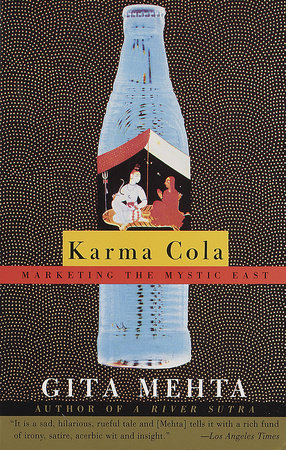Gita Mehta, Karma Cola: Marketing the Mystic East (1979)
By the late seventies, the image of Westerners in floppy shirts traipsing after Indian gurus was already a cliche, with Hare Krishnas in airports and Stevie Wonder declaring that Transcendental Meditation gives you peace of mind (in a song called, of all things, “Jesus Children of America”). It was to this peculiar state of affairs — the West, long seen by Indians as the seat of sophistication and the model of development, now turning to the East for wisdom — that Gita Mehta turned her eye, delivering a slim but devastating volume that sends up, gently and sympathetically but relentlessly, the credulous Westerners and the gurus who prey on them.
This theme of West meeting East is one that Pico Iyer would pick up a few years later, more fully and incisively, in Video Night in Kathmandu, but Mehta deserves some credit for getting there first, just a year after Edward Said’s Orientalism (and Peter Matthiessen’s The Snow Leopard, that paean to the mystic power of the Himalayas and the plausibility of yetis). But Mehta has none of Said’s rage and none of his showy erudition. She shows great compassion for the lost souls washing up on her shores, and also a clever understanding of how strange it is for ordinary Indians (or at least ordinary educated Indians) to adjust to the notion that they, and not the West, have Got It Right.
There’s a lot in this book that’s very, very good, though at times her circumspect, elliptical style can become a liability. Nothing is footnoted, and one wishes that references to “an Indian writer” and the like were less cryptic. There’s in irony in a book like this asking us to take so much on faith. Still, it captures a flavor of absurdity that was familiar enough both from my upbringing in the Marin of the seventies and eighties and my own travels in India. (I remember an older woman, after telling me she and her husband had just come from the Osho asharm in Pune, looking me intently in the eye, sliding a hand along my thigh, and declaring, “You should go. It’s amaaaazing!”)
It took me a while to realize that I had read this book before, twenty-five years ago, on my first trip to India. Bits and pieces seemed familiar, and then I came to the part about Goa. I remembered the image of the naked Brazilian man with the silver fluete being pimped out at the Anjuna Flea Market, which I attended and found to be dustier but not more impressive than the Guerneville Flea Market in Sonoma, which is not very impressive. There was no naked floutist.

